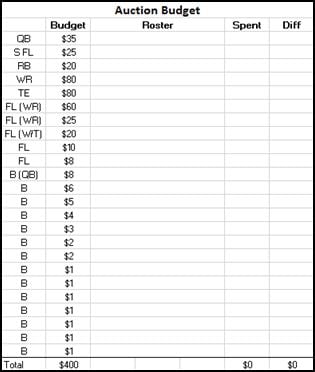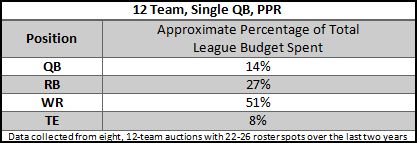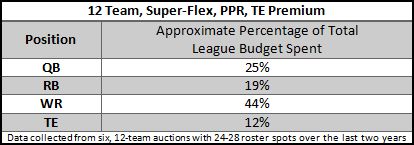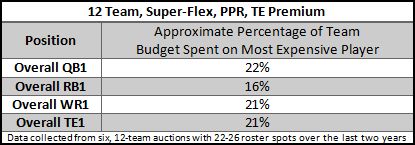Auction 101: Preparation
Just like dynasty to redraft, auctions are obviously superior to drafts. If you’re not sold on why, check out yesterday’s article which was cleverly named, Auction 101: So Much Better than Drafts.
Over the last handful of years, I’ve participated in countless auctions. While that experience hardly make me an expert on the topic, it has taught me some valuable lessons. So whether you’re new to startup auctions or are a seasoned pro, I hope some of the tips and tricks I’ve come across over the years can help you avoid the pitfalls that so many bidders suffer through.
There are two main factors to building a successful roster during an auction. Preparation is the first step. It’s imperative before the auction begins to lay out a solid game plan which will help keep you on track during the auction. Secondly, the execution of the strategy created from that preparation is equally as important.
This article will focus on the preparation portion of building a roster in an auction.
The Rules
[am4show have=’g1;’ guest_error=’sub_message’ user_error=’sub_message’ ]
There are a few things when preparing for a startup that are exactly the same whether you are drafting players or bidding on them. Knowing the rules to your league is one of them. In fact, you should have a pretty good grasp on them before accepting an invitation to join the league, but that’s for another article.
The primary questions you should ask yourself when preparing for a startup include:
- How many teams are in the league?
- How many roster spots does each franchise have? (Is there a minimum or a maximum?)
- How many starting spots will you field every week? (Is it super-flex and is a TE required?)
- What are the scoring settings? (Is the league PPR or TE Premium?)
There are also a couple of questions you should answer that are specific to auction.
- How much is each team’s budget?
- How will the players be nominated?
- Is the auction a live auction or a slow auction? (Live auctions can take place in person or online and typically take a few hours to complete while slow auctions happen online over the course of days or even weeks.)
The answers to these questions will be incredibly helpful as you prepare for your auction. Be sure you know exactly what the league’s settings are before going forward with your preparation.
The Budget
If there is nothing else you take from this article, remember the following sentence. A successful auction starts with a budget.
It really isn’t difficult to do. Using the information you gathered above, write down each starting position as well as the amount of bench spots that are required to be filled in the auction. Then put a dollar amount next to each roster spot. Those numbers should equal the total budget allowed for each team. I like to build my budget in excel and it looks something like this.

This example could be used during a $400 auction in a super-flex league with 24 roster spots. As you can see, every roster spot is listed in the far left column. Note that I also placed a few positions in parenthesis in the flex and bench spots. I do this in an effort to plan my roster composition the best I possibly can. Following the position column, I include a “Budget” column for the rough starting budget I put together, as well as the “Roster” column which is a place for the players’ names as auctions are won. Finally, the “Spent” column is for the final cost of the player and the “Diff” (difference) column will calculate how much money I saved or overspent by.
Obviously, this could be done very simply with a pen and a piece of paper and doesn’t necessarily have to include as many columns, but this system has worked well for me over the years.
When the auction starts, this can be edited as you learn the cost of players as well as the tendencies of the auction room, but we’ll get to that as we progress.
As I stressed above, budgeting is the most important part of your auction preparation. There are plenty of dynasty owners that completely ignore building a budget. While some of the best fantasy minds I know have had successful auctions without a budget, most of the worst dynasty teams I’ve ever seen were put together by an owner that decided to “wing it” during the auction. That’s too risky of a move for me.
The Cheat Sheet
Along with knowing the rules to your league, building a cheat sheet is the other part of preparation that is similar whether you’re participating in an auction or a draft.
It’s as simple as creating a set of rankings by position. Once again, by using the information you gathered when answering the questions above about your league’s rules, you should have a pretty good grasp on how many players you’ll need to rank to be properly prepared. For example, a 12 team league with 24 roster spots will need a minimum of 288 total players ranked.
Like with the budget, I like to create my cheat sheets in excel. This will make it easy to track the auction once it starts (but we’ll get to that.) Here is a snapshot of what my cheat sheet looks like at this point in the process.

The only necessary part of your rankings is the list of players’ names but I prefer to include the age of each player so I have that information at my fingertips. The “Price” column is also imperative in my opinion as it allows me to update the information as the auction goes on. Again, we’ll get to the updates as we go on.
A good way to create a cheat sheet is to use the DLF positional rankings. By simply copying them and pasting them into excel, you can edit them relatively quickly (plus you’ll have the players’ age built into your spreadsheet.)
Auction Expectations
The next thing you need to do when preparing for your auction is to try to get a gauge on what to expect when the auction starts. Knowing how much money is likely to be spent on each position and what percentage of a team’s budget should be spent on elite players will give you a leg up on the competition. Luckily, I have compiled some of that information over the last couple years.
Let’s start with the overall percentage of money spent on each of the four main positions. Obviously, these numbers can change slightly with every auction and can change with large rosters, more or less starting spots and by adding kickers or defensive positions. All owners should also know that every auction room is different and the amount of money spent on a position group can change drastically if you happen to be in a league full of guys that prefer to build through a specific position or where the spending gets out of control on top-level talent. With that said, these numbers should give auction players a good gauge on what to expect as an auction kicks off.


The first thing that jumps out when looking at this data is the percentage of money spent on wide receivers. No matter the league settings, that number has slowly risen by 1%-2% with each year that has passed over the last three years. That increase has been mirrored by a 1%-2% drop in the money spent on running backs over the same span.
Many of you may be wondering why the above information is useful. More than anything, it helps when creating a budget. If you know how much the league will spend on a specific position, you should be able to use it to plan your spending for each position, whether that be by following suite or by finding places to save money.
While we’re talking about auction expectations, it’s also helpful to know what elite players at each position go for when preparing for an auction.


The top takeaway from this data is that you can plan on spending around one-fourth of your budget on elite players, no matter the position. It’s also worth noting that no matter the league settings, Rob Gronkowski has been worth nearly 35% more than the next most valuable tight end over the last two years.
Although some may say that basing this data on a total of just 14 leagues may be a bit shortsighted due to the small sample size, it has been very consistent over the leagues and makes me believe the numbers are relatively dependable.
The Auction
Now that you have a budget, a cheat sheet and have a good gauge on what to expect when the nominations begin, it’s time to dominate your auction. Check back tomorrow to find out my tips on how to execute your game plan and control your auction from start to finish.
[/am4show]
- League Tycoon: Dynasty Salary Cap Fantasy Football - December 15, 2023
- Final Dynasty Rookie Report Card: Wide Receivers, Part Two - March 22, 2023
- 2023 NFL Scouting Combine: Offensive Player Dynasty Review - March 10, 2023


































































